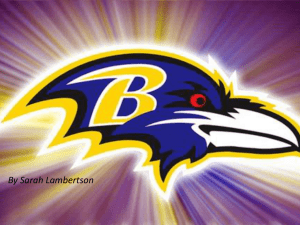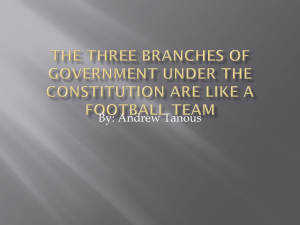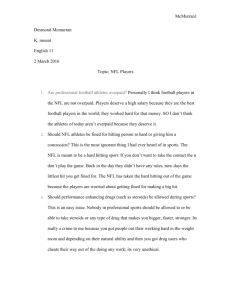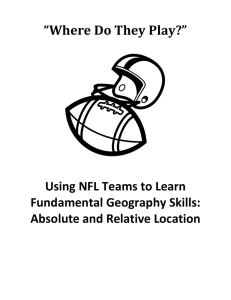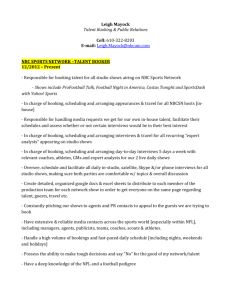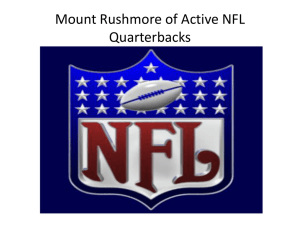Coaching Diversity: The Rooney Rule, Its Application and Ideas for
advertisement
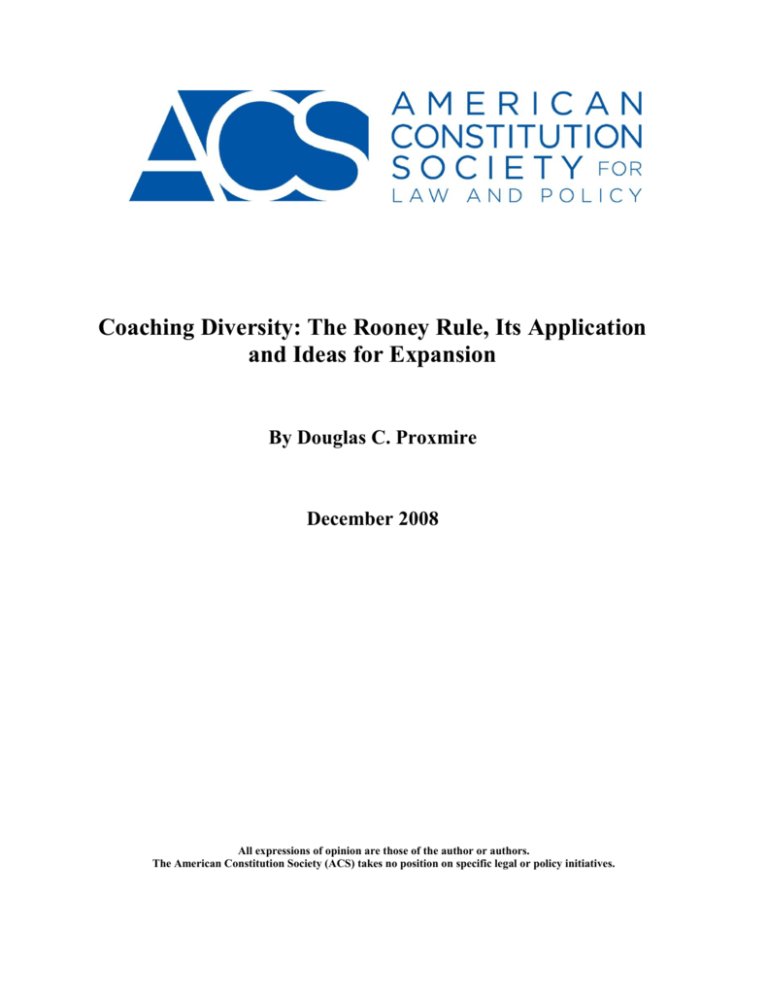
Coaching Diversity: The Rooney Rule, Its Application and Ideas for Expansion By Douglas C. Proxmire December 2008 All expressions of opinion are those of the author or authors. The American Constitution Society (ACS) takes no position on specific legal or policy initiatives. Coaching Diversity: The Rooney Rule, Its Application and Ideas for Expansion Douglas C. Proxmire* On January 22, 2007, the Pittsburgh Steelers held a press conference to announce the hiring of Mike Tomlin as their new head coach. At the age of 34, Tomlin became the secondyoungest head coach in the National Football League (“NFL”) and the tenth African-American coach in NFL history. As a sign of the NFL’s progress in the hiring of minority candidates to NFL head coaching positions, Tomlin’s race proved to be far less of an issue than Tomlin being picked over two long-time Steelers assistant coaches, Ken Whisenhunt and Russ Grimm. Pittsburgh chose Tomlin over Grimm, Whisenhunt, and at least nine others, even though Tomlin was the youngest candidate and had no connection with the Steelers organization as a player or an assistant coach. Given that Tomlin had no head coaching experience, had spent only one season as a defense coordinator, and at 34 was younger than some of the players on the Steelers’ roster, Tomlin was considered the longshot among the dozen candidates vying for the head coaching spot of one of the NFL’s marquee franchises. Nonetheless, Tomlin “bowled over”1 Pittsburgh team chairman Dan Rooney and team President Art Rooney after a round of interviews with the Steelers front office. Tomlin’s intelligence, presence and charisma convinced the Steelers front office that Mike Tomlin was the person best-suited to succeed Bill Cowher and Chuck Noll, two legendary Steelers head coaches who also were hired at similarly young ages.2 Mike Tomlin’s ability to rise up and distinguish himself during the Pittsburgh interview process highlighted the continuing value of the “Rooney Rule” for both NFL teams and for minority candidates. The Rooney Rule requires that an NFL team with a head-coaching vacancy must interview one or more minority candidates for the position; given the NFL’s woeful history of considering and hiring minority candidates to fill head-coaching slots until the implementation of the Rooney Rule, the question can be reasonably asked as to whether Pittsburgh would have even considered Mike Tomlin as a candidate for the Steeler head job without the Rooney Rule. On its face, the Rooney Rule might appear to be solely about racial diversity in leadership positions within the NFL, but in fact, a discussion of the Rooney Rule involves broader issues that affect not just the NFL, but also other segments of the sports world, as well as employers at large. The Rooney Rule casts a spotlight on several critical workplace diversity issues, including the importance of having managerial leadership reflect the diversity of a workforce, strategies for ensuring that the best people for the job are considered, and tools for combating unconscious bias in hiring and promotion decisions. The balance of this paper will examine the development of the NFL’s Rooney Rule, its adoption and impact on the NFL, and the possibility for the use of a similar rule for other NFL positions and for other industries. * Douglas C. Proxmire is a partner at Patton Boggs LLP in Washington, DC. Gerry Dulac, Tomlin, 34, is NFL's Rising Coaching Star, PITTSBURGH POST-GAZETTE, Jan. 18, 2007, available at http://www.post-gazette.com/pg/07018/754788-66.stm. 2 Id. 1 1 I. The Adoption of the Rooney Rule In 1921, Frederick Douglass “Fritz” Pollard, an African-American, was named player and co-head coach of the Akron Pros of the American Professional Football Association (“APFA”), the precursor to the NFL. Incredibly, Pollard would prove to be an exception, as over the next 68 years, no APFA or NFL team hired another African-American as a head coach until the Oakland Raiders hired Art Shell in 1989. In the twelve year period between 1989 and 2001, NFL franchises hired only five African-American head coaches, including an interim head coach with a term of three games. At the conclusion of the 2001 season, African-Americans comprised approximately 67% of the NFL players, but only 6% (2 out of 32) of the league’s head coaches.3 In light of the vast disparity between African-American player participation and coaching representation and the NFL’s seventy-plus year track record of failing to interview and hire African-American coaches except in rare cases, outside forces applied increasing pressure on the NFL to take affirmative steps to ensure that qualified African-American coaching candidates would be given opportunities to be considered for NFL head-coaching positions. Exerting one of the strongest influences on the NFL to change its hiring practices was the team of litigator Johnnie L. Cochran Jr., civil rights attorney Cyrus Mehri, and labor economist Dr. Janice Madden. The three joined forces in 2002 to produce a detailed report on the NFL’s head-coaching hiring practices, entitled “Black Coaches in the National Football League: Superior Performance, Inferior Opportunities.” This report exhaustively analyzed the NFL’s hiring and firing practices over the previous fifteen seasons prior to 2002, and the statistics were revealing and disappointing. Among the findings: Black coaches averaged 1.1 more wins per year than white coaches.4 Black coaches led their teams to the playoffs more frequently than white coaches (67% of the time for black coaches versus 39% of the time for white coaches).5 In the last season before being fired, black coaches won an average of 1.3 more games than white coaches in their last seasons.6 In the first season after being hired, black coaches won an average of 2.7 more games than white coaches in their first seasons.7 3 RICHARD LAPCHICK WITH BOMA EKIYOR & HORACIO RUIZ, UNIV. OF CENT.FLA. DEVOS SPORT BUS. MGMT. PROGRAM, THE 2006 RACIAL AND GENDER REPORT CARD: NATIONAL FOOTBALL LEAGUE 17 (2007). 4 JOHNNIE L. COCHRAN, JR. & CYRUS MEHRI, BLACK COACHES IN THE NATIONAL FOOTBALL LEAGUE: SUPERIOR PERFORMANCE, INFERIOR OPPORTUNITIES, at ii (2002). 5 Id. 6 Id. 7 Id. 2 The evidence led to an obvious, but disconcerting, conclusion: despite an overall better record than their white counterparts, black coaches had a difficult time getting hired, and once hired, black head coaches were fired before their white counterparts. After the publication of the Cochran/Mehri/Madden Report, Cochran, Mehri, NFL Hall of Famer Kellen Winslow and former NFL pro-bowler and NFL executive John Wooten decided to start contacting NFL teams to discuss minority hiring practices. They intended to find a way to break the glass ceiling holding back promising minority coaching candidates. Through meetings with NFL executives, the Cochran/Mehri/Winslow/Wooten group, which became known as the Fritz Pollard Alliance,8 raised awareness of the need to address and remedy the league’s collective failure to consider and hire minority head coaching candidates. On October 31, 2002, due to the rising concern about potentially discriminatory leaguewide hiring practices, the NFL appointed a “Committee on Work Place Diversity” headed by Steeler President Dan Rooney to study the NFL’s hiring practices, determine whether remedial action should be taken, and if necessary, recommend a plan for such action. On December 20, 2002, the Committee issued its recommendations, including that the NFL:9 make a commitment to interview minority candidates for every head coaching job opening (unless the team had already made a prior commitment to hire a person from within its own staff); establish a coordinator/assistant head coach databank to assist NFL teams in the consideration of qualified coaching candidates; and allow early interview opportunities for assistant coaches of playoff teams. The NFL owners held a series of conference calls to discuss the Committee’s recommendations, and the owners “strongly agreed on the principle that any club seeking to hire a head coach will interview one or more minority applicants for that position.”10 By the owners’ adoption of the Committee’s recommendations, the “Rooney Rule”11 (named after Dan Rooney, the chair of the Committee) became binding on all NFL teams, and any team found in violation of the Rooney Rule (i.e., failing to interview a minority candidate before filling a head coach vacancy) would now be subject to penalties at the NFL Commissioner’s discretion. While the announcement of the NFL’s adoption of the Rooney Rule demonstrated the league’s acknowledgement that the under-representation of African-Americans among NFL head coaches was a problem, concerns remained about the implementation and enforcement of this new rule. The Fritz Pollard Alliance suggested that the NFL incentivize the Rooney Rule by providing an additional draft pick to teams that hire a minority candidate, while also taking away 8 In 2003, this group officially took the name the “Fritz Pollard Alliance” in honor of the first African-American NFL coach. 9 Press Release, National Football League, NFL Clubs to Promote Diversity Program (Dec. 20, 2002), available at www.nfl.com/news/story/6046016. 10 Id. 11 Interestingly, it does not appear that the NFL ever formally adopted the Rooney Rule in its by-laws, and there is no memorialized Rooney Rule text other than the NFL’s December 20, 2002 press release. 3 draft picks from teams that fail to interview a minority candidate for an open head coaching position. Until the League actually enforced the Rooney Rule by punishing a team that failed to comply, considerable doubt remained as to whether the Rooney Rule would have any actual impact. II. The Implementation and Enforcement of the Rooney Rule and its Impact on the NFL After the adoption of the Rooney Rule in December 2002, the number of AfricanAmerican head coaches increased from two in 2002 to an all-time high of seven in 2006, but the numbers have leveled off since 2006. Midway through the 2008 season, there were seven African-American head coaches, including interim head coach Mike Singletary of the San Francisco 49ers. Most significantly, the additional coaching opportunities created over the last five years have led to on-the-field success for the teams headed by these coaches. In 2005, teams coached by African-Americans won three division titles (Lovie Smith – Chicago Bears, Tony Dungy – Indianapolis Colts and Marvin Lewis – Cincinnati Bengals). The next year, in Super Bowl XLI, both conference winners were headed by African-American coaches – Dungy and Smith. While Dungy was already a head coach at the time the Rooney Rule was implemented in 2002, Smith acknowledged that he likely would not have been considered for a head coaching job without the Rooney Rule.12 While the success of Dungy and Smith may now contribute to NFL teams’ willingness to comply with the Rooney Rule when considering candidates to fill coaching vacancies, early on, NFL teams got the message that they needed to incorporate the Rooney Rule’s guidelines into their hiring practices or sanctions would be levied. Cochran and Mehri’s report had proposed awarding draft picks as an incentive for teams to hire minority candidates (as part of what they called a “Fair Competition Resolution”).13 Instead, the NFL established a different precedent of punishment for teams failing to comply with the Rooney Rule. In 2003, soon after the Rooney Rule was adopted, the Detroit Lions were looking for a head coach, and the team president, Matt Millen, made it clear to the candidates that the Lions expected to hire Steve Mariucci as the Lions’ next coach. At the time, Mariucci was considered a desirable candidate as he had coached the San Franciscos 49ers to the playoffs four times in the previous six years. In addition to his record of taking the 49ers to the playoffs, he was a Michigan native, and thus, a natural fit for the Lions. Perhaps because the Lions’ intention to hire Mariucci was made known by Millen, five minority coaching candidates understandably turned down Millen’s request for an interview with the Lions. Concerned that time was slipping away and that Mariucci might become the target of another NFL franchise if the Lions did not act quickly, the team ceased its efforts to interview anyone else for the job and hired Mariucci in 2003 without interviewing any minority candidates. The NFL responded strongly to the circumstances surrounding the Mariucci hire. Determining that the Lions had failed “to take sufficient steps to satisfy its commitment to the 12 Brian W. Collins, Tackling Unconscious Bias in Hiring Practices: The Plight of the Rooney Rule, 82 N.Y.U. L. REV. 870, 908 n.219 (2007). 13 COCHRAN & MEHRI, supra note 4, at iii-iv. 4 Rooney Rule,” NFL Commissioner Paul Tagliabue publicly reprimanded the Lions and fined the team $200,000 for conduct detrimental to the league. Tagliabue sent an unmistakable message by declaring that the next violator will face a $500,000 fine. 14 Since the NFL never formally identified the range of potential sanctions when/if a team violates the Rooney Rule, it is not clear whether the Commissioner can or would levy non-monetary sanctions (e.g., the loss of draft picks) in addition to monetary sanctions for further Rooney Rule violations. Other than the 2003 fine and reprimand levied on the Detroit Lions, no other NFL team has been found in violation of the Rooney Rule when hiring a head coach.15 By the Commissioner’s determination, all other teams looking for a head coach since 2003 have taken sufficient steps to be in compliance. Nevertheless, heading into the 2008 season, only six of thirty-two (19%) NFL teams were coached by minorities. In addition, before the 2007 season, none of the four head coaching vacancies were filled by minority candidates even though none of the four new hires had head coaching experience. Similarly, before the 2008 season, none of the four head coaching vacancies were filled by minority candidates, and again, none of the new hires had head coaching experience. 16 While the hiring results from the Rooney Rule are mixed (i.e., the number of minority NFL head coaching hires has increased, but a wide disparity remains between the percentage of African-American players and the percentage of African-American head coaches), the rule appears to have helped reduce the “unconscious bias” 17 that remains pervasive in the NFL. In 1992, NFL Hall of Fame Coach Bill Walsh described unconscious bias in the following way: “the hiring of coaches is . . . a very fraternal thing. You end up calling friends, and the typical coach has not been exposed to many black coaches.”18 More work remains to be done to remedy this unconscious bias. While the number of African-American assistant coaches has increased since 1992, a disparity still exists between the percentage of African-American players and the percentage of African-American assistant coaches.19 Additionally, the NFL has no African-American majority team owners, no AfricanAmerican CEOs or team presidents, and only four of the thirty-two NFL teams have AfricanAmerican general managers or player personnel directors.20 As a result of the lack of African14 Lions' Millen fined $200K for not interviewing minority candidates, SPORTSLINE.COM, JULY 25, 2003, http://cbs.sportsline.com/nfl/story/6498949. 15 In October 2008, the NFL did reject the draft contract between interim head coach Jim Haslett and the St. Louis Rams that would have ensured the Rams head-coaching job for Haslett if he reached a certain win threshold over the remainder of the 2009 season. In rejecting the contract, the NFL explained that the Rooney Rule required that the Rams interview a minority head coaching candidate when a head coaching vacancy exists, and the league ruled that the proposed Haslett contract violated that requirement. NFL Rejects Haslett’s Win-Based Contract With Rams, SPORTINGNEWS.COM, OCT. 25, 2008, http://www.sportingnews.com/yourturn/viewtopic.php?t=478303. 16 The San Francisco 49ers did hire African-American Mike Singletary as interim head coach midway through the 2008 season. This hire raised the number of NFL black head coaches to seven (21.8% of NFL teams). 17 Claire Smith, BASEBALL: EQUALITY'S HURDLES - A Special Report; Too Few Changes Since Campanis, N. Y. TIMES, Aug. 16, 1992. 18 Id. 19 As of the end of the 2006 season, 35% of the NFL assistant coaches were black, 62% were white, 2% were Latino and 1% Asian. When the Rooney Rule was adopted prior to the 2003 season, 30% of the NFL assistant coaches were black. LAPCHICK WITH EKIYOR & RUIZ, supra note 3, at 18. 20 Id. at 16, 19, 20. 5 American owners and high-ranking front office personnel, evidence remains that this unconscious bias still exists in the NFL, making it difficult for African-American coaching candidates to receive the same opportunities as white coaching candidates.21 While the Rooney Rule has made only slow progress to counteract this unconscious bias, the Rule has at least caused each NFL team looking to fill a head coaching position to make extensive contact with a minority candidate who may impress the decision-makers and receive the job or alternately be considered for future coaching opportunities as a result of the interview. In order to prevent sham interviews, or at least to change the perception that interviews of minority candidates are merely a pro forma exercise before making the hiring decision, the NFL has an interview policy, which, among other things, prohibits telephone interviews and requires that the majority owner meet with the head coaching candidate for the contact to constitute an interview. Additionally, it appears that the Rooney Rule has led to some progress for other NFL minority hiring practices. In the five years since the Rooney Rule has been implemented, the number of minority hires in NFL head coaching, assistant coaching and front offices has increased.22 In the University of Central Florida DeVos Sport Business Management Program’s most recent Racial and Gender Report Card, which assessed the minority hiring practices at all front office and coaching levels among league teams, the NFL “raised its grade for race to a solid B+ approaching an A- with a score of 88.5 out of 100.”23 While it is impossible to quantify the precise impact of the Rooney Rule on the NFL’s hiring practices, it is reasonable to conclude that the Rooney Rule has played a material role in the gains realized by minority coaching and front office candidates over the past six years. III. Expanding the Rooney Rule’s Application Currently, the Rooney Rule remains unique to the NFL, and more specifically, it applies only to NFL teams looking to hire head coaches. The limited scope of the Rooney Rule does not cover the hiring of front-office personnel or other coaching staff positions, such as coordinators. While there has been talk about expanding the Rooney Rule to cover additional vacancies, the NFL has yet to take that step.24 However, the NFL has indicated that it is exploring the possibility of expanding the Rooney Rule to require that a minority candidate be interviewed when the NFL teams look to fill “top front office vacancies.”25 Only time will tell whether the 21 It is this “unconscious bias” that the Rooney Rule seeks to address by compelling NFL teams to at least interview one minority candidate before hiring an NFL coach. 22 LAPCHICK WITH EKIYOR & RUIZ, supra note 3, at 17, 18, 20, 22. 23 Id. at 1. 24 Marke Maske, Expansion of the Rooney Rule Meets Resistance, WASH. POST, Apr. 13, 2006, available at http://www.washingtonpost.com/wp-dyn/content/blog/2006/04/13/BL2006041300782.html. 25 Gary Mihoces, NFL Minority Hiring, USA TODAY, FEB. 3, 2007. When asked about expanding the Rooney Rule to include front office positions, NFL Commissioner Roger Goodell responded, “It's a good question. We've thought about it a lot.” However, he did not commit the league to expanding it. “The great news about the Rooney Rule, I hope some day it's not going to be necessary,” he said. “And I feel the same way about the front office. Clubs are doing it voluntarily because they believe it’s paying dividends for them, and they’re benefiting, and, most importantly, it’s the right thing to do.” 6 NFL is willing to expand the Rooney Rule and enforce it to cover NFL front office job vacancies. NCAA Division 1 college football would appear to be the next logical arena for adoption of the Rooney Rule, as some measure is desperately needed to address the woeful disparity between minority head coaches and minority Division 1A26 football players. Even though more than half of Division 1A college football players are African-American, only six of the 119 NCAA Division 1A head coaches are African-American (about 5%).27 That number may further dip as two of the six African-American coaches (Ron Prince at Kansas State and Ty Willingham at University of Washington) plan to step down after the 2008 season.28 If the number of African-American Division 1A coaches remains at four after the 2008 season, the number of African-American coaches in Division 1 football will drop to its lowest level in fifteen years.29 Despite the ongoing under-representation of men of color in the NCAA coaching ranks, the NCAA has resisted calls to implement the Rooney Rule for college football.30 While the NCAA has resisted taking the formal step of implementing the Rooney Rule, the NCAA Division 1 Athletic Director’s Association has made a commitment to interview at least one minority candidate when an NCAA Division 1 football head coaching position opens.31 While this commitment will not include the threat of sanctions like the NFL’s Rooney Rule, the promise to interview at least one minority candidate constitutes an acknowledgement that a problem exists, and it is receiving some attention.32 Dutch Baughman, Executive Director of the Athletic Directors’ Association, said that committing, without penalty, to interview at least one minority candidate when a major college head coaching position is open is “the best we can do,” while respecting “the fact that there’s institutional prerogative” on all hiring decisions.33 The 2009 off-season will be the first time that this commitment from the NCAA Athletic Directors Association will be in effect. Evaluating whether this nonbinding commitment to interview is effective enough to remedy the considerable underrepresentation of minority head coaches in major college football will need to take place over time. Similar to college football, Major League Baseball (“MLB”) and the National Basketball Association (“NBA”) have no formal policies akin to the Rooney Rule. While not as vast a difference as noted in the NFL, MLB and the NBA also suffer from a disparity between the 26 Division 1A Football is also known as the NCAA Division 1 “Football Bowl Subdivision” and constitutes those schools that compete for the BCS Championship each year, which includes those schools in the Atlantic Coast, Big East, Big Ten, Big Twelve, Pac-10 and Southeastern conferences, among others. 27 RICHARD LAPCHICK WITH JENNY BRENDAN, UNIV. OF CENT.FLA. DEVOS SPORT BUS. MGMT. PROGRAM, THE 2006-2007 RACIAL AND GENDER REPORT CARD: COLLEGE SPORTS 12 (2008). 28 Mark Wagrin, Study: Black Coach Numbers Lowest in 15 Years, USA TODAY, NOV. 6, 2008. 29 Id. 30 The Lack of Diversity in Leadership Positions in NCAA Collegiate Sports: Hearing Before the Subcomm. on Commerce, Trade and Consumer Prot. of the H. Comm. On Energy and Commerce, 107th Cong. (2007) (Statement of Myles Brand, NCAA President), available at http://energycommerce.house.gov/cmte_mtgs/110ctcp_hrg.022807.Brand-testimony.pdf. 31 Steve Wieberg, Minority-hiring Policy Stiffens for Major Football Programs, USA TODAY, JAN. 16, 2008. 32 Id. 33 Id. 7 percentage of minority players and the percentage of minority coaches and front office personnel.34 A summary of the percentage of minorities in key roles for MLB, the NBA and the NFL is set forth below: Percentage of Minorities in Key Roles: Players Managers/Head Coaches Coaches/Assistant Coaches CEOs General Managers Vice Presidents Major League Baseball 40.1% 27% National Basketball Association 80% 40% National Football League 69% 19% 31% 42% 38% 0% 6% 10% 23% 23% 15% 0% 13% 8% As set forth above, even with the benefit of the Rooney Rule, the current group of NFL coaches and executives does not come close to reflecting the racial backgrounds of the players working under them, and the NFL’s percentage of minorities in coaching or front office positions as compared to the percentage playing the sport still lags behind the other major sports leagues in the United States. As a result, MLB and the NBA do not appear to receive the same public pressure and attention as the NFL or even major college football to institute formal procedures with the intent of increasing minority coaching hires. IV. Conclusion As the center of the American sporting universe, the NFL is in a unique position to take steps to further reduce the disparity between the percentage of minority athletes that play in the NFL and the percentage that hold coaching and front office jobs. Those steps could include expanding the Rooney Rule to cover offensive/defensive coordinator and key front office positions. Also, the NFL Commissioner could levy non-monetary penalties (e.g., the loss of draft picks) upon teams that fail to honor the Rooney Rule. A version of the Rooney Rule is now being informally implemented, admittedly without the teeth of a penalty, by the Athletic Directors representing universities playing major college football. In addition to expanding the scope of the Rooney Rule in the NFL, due to the high profile that the NFL holds and due to the fact that NFL owners also head many of the largest corporations in the United States, the application and expansion of the Rooney Rule has the opportunity to influence societal practice. The continued use of the Rooney Rule to promote advancement of minorities to the highest positions in the NFL could help convince other industries of the benefit of implementing a similar rule in non-sports related businesses. 34 LAPCHICK WITH EKIYOR & RUIZ, supra note 3, at 1. 8 While the implementation of such a rule outside of the NFL would likely have to be voluntary in most instances, as there is no “commissioner” to enforce such a rule on Fortune 500 companies, individual businesses could vow to implement a requirement that at least one minority candidate must be considered and interviewed when executive positions in their organization become open. As established through the implementation of the Rooney Rule in the NFL, the fundamental benefit of the rule is self-serving: by forcing businesses to consider and evaluate the best candidates who otherwise might be overlooked for advancement, the rule combats unconscious bias and increases the chances of selecting the best person for the job. Just as Mike Tomlin “bowled over” Dan Rooney during his round of interviews with the Pittsburgh Steelers, providing a similar opportunity to at least one minority candidate when other businesses consider and recruit executives could prove to be a valuable tool to improve and diversify other businesses and industries. 9

